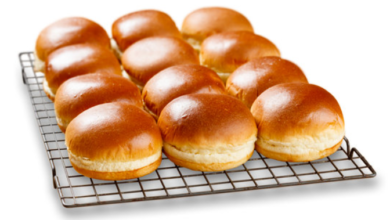Brioche Is More Than a Dessert

What To Know
- In France, brioche is a staple of bakeries and patisseries, enjoyed as a breakfast pastry or a dessert.
- Ultimately, the classification of brioche depends on how it is served and the context in which it is consumed.
- While brioche is not considered a health food due to its high butter and sugar content, it can be enjoyed in moderation as part of a balanced diet.
Brioche, a delectable bread with a rich history and distinctive flavor, has sparked a culinary debate: is it a dessert or a savory bread? This blog post delves into the nuances of brioche, exploring its origins, ingredients, and the diverse ways it’s enjoyed to answer this intriguing question. Join us as we embark on a culinary adventure to uncover the true nature of brioche.
The Origins of Brioche
Brioche traces its roots back to the 16th century in Normandy, France. It is believed to have originated as a festive bread, often prepared for special occasions such as weddings and religious holidays. The name “brioche” is derived from the French word “broyer,” meaning “to knead,” hinting at the labor-intensive process involved in its creation.
Ingredients of Brioche
The traditional ingredients of brioche include flour, water, yeast, sugar, eggs, butter, and sometimes milk. The high proportion of butter and eggs in the dough contributes to its rich, tender texture and distinctive golden-brown color. The use of sugar gives brioche a subtle sweetness, while the yeast provides a light, airy crumb.
Types of Brioche
Brioche comes in various shapes and sizes, each with its unique characteristics:
- Traditional Brioche: A classic cylindrical loaf with a soft, fluffy interior and a golden-brown crust.
- Brioche à Tête: A round-shaped brioche with a distinctive “head” on top, often decorated with a pearl sugar topping.
- Savarin: A ring-shaped brioche soaked in a sweet syrup and filled with fruit or whipped cream.
- Gâche: A flat, round brioche from the Vendée region of France, known for its dense, chewy texture.
Brioche as a Dessert
Brioche’s inherent sweetness makes it a popular choice for desserts. It can be served plain or filled with a variety of sweet fillings, such as:
- Chocolate: Rich and decadent chocolate fillings complement brioche’s rich flavor.
- Fruit: Fresh or dried fruits, such as berries, apples, and raisins, add a burst of sweetness and color.
- Custard: Creamy custard fillings provide a velvety smoothness to brioche.
- Jam: Tart or sweet jams offer a classic combination with brioche.
Brioche as a Savory Bread
Despite its sweet undertones, brioche can also be enjoyed as a savory bread. Its versatility allows it to pair well with a range of savory ingredients:
- Cheese: Brioche’s rich flavor complements the saltiness of cheeses, such as cheddar, brie, and goat cheese.
- Meat: Brioche makes excellent sandwiches with ham, bacon, or roast beef.
- Eggs: A fried or poached egg on top of brioche creates a satisfying and flavorful breakfast or brunch.
Brioche in Different Cuisines
Brioche has found its way into various cuisines around the world:
- French Cuisine: In France, brioche is a staple of bakeries and patisseries, enjoyed as a breakfast pastry or a dessert.
- American Cuisine: In the United States, brioche is often used in French toast, bread pudding, and other breakfast dishes.
- Japanese Cuisine: In Japan, brioche is known as “koppepan” and is popular as a sweet bread filled with various fillings.
So, Is Brioche a Dessert?
The answer to the question “is brioche a dessert” is not a definitive yes or no. Brioche’s versatility allows it to be enjoyed both as a dessert and a savory bread. Its rich flavor and soft texture make it a perfect accompaniment to sweet and savory dishes alike. Ultimately, the classification of brioche depends on how it is served and the context in which it is consumed.
Wrap-Up: The Enduring Appeal of Brioche
Brioche, with its unique blend of sweetness and savoriness, has captured the hearts of bread enthusiasts worldwide. Whether enjoyed as a decadent dessert or a versatile bread, brioche continues to delight our taste buds and enrich our culinary experiences. Its enduring appeal is a testament to the skill and artistry of bakers who have perfected this timeless bread for centuries.
Basics You Wanted To Know
1. Is brioche healthy?
While brioche is not considered a health food due to its high butter and sugar content, it can be enjoyed in moderation as part of a balanced diet.
2. Can brioche be frozen?
Yes, brioche can be frozen for up to 3 months. To freeze, wrap the brioche tightly in plastic wrap and place it in a freezer-safe bag.
3. How do I store brioche?
Brioche can be stored at room temperature for up to 3 days. If not consumed within that time, it should be stored in the refrigerator for up to 5 days.
4. Can I make brioche at home?
Yes, brioche can be made at home with a stand mixer or a bread machine. However, it is a labor-intensive process that requires patience and attention to detail.
5. What are some creative ways to serve brioche?
Brioche can be served in various ways, including:
- As a breakfast sandwich with eggs, bacon, and cheese
- As a dessert with chocolate ganache or fruit compote
- As a stuffing for poultry or fish


